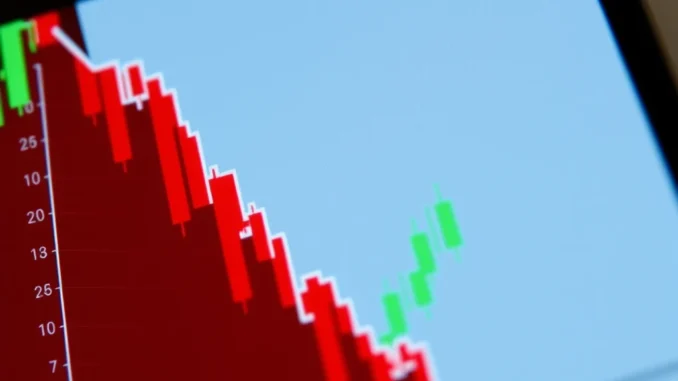
Is the crypto hype train slowing down? Recent reports indicate a significant shift in the digital asset landscape, particularly for popular trading platforms. Let’s dive into the latest figures from Robinhood, a platform known for its accessibility to both stock and cryptocurrency trading, and what a dramatic decrease in crypto trading volume might signify for the broader market.
Why is Robinhood’s Crypto Trading Volume Down?
According to a CoinDesk report, Robinhood crypto trading experienced a sharp decline of 29% in February compared to the previous month. While a month-on-month dip might seem concerning, it’s crucial to understand the broader context. Here’s a breakdown of the key points:
- Significant Drop: A 29% decrease in crypto trading volume is a substantial shift, indicating potentially reduced user activity or interest in crypto trading on the platform.
- Outpacing Other Assets: Interestingly, the decline in crypto trading volume on Robinhood was more pronounced than the decrease in stock and options trading. This suggests that the slump is more specific to the cryptocurrency sector within the app.
- Year-on-Year Growth: Despite the recent dip, it’s important to note that Robinhood’s crypto trading volume is still 122% higher than it was during the same period last year. This year-over-year growth, while positive, is overshadowed by the recent monthly decline, hinting at a potential change in momentum.
- Market-Wide Trend: The report points out that this downward trend in trading volume decline isn’t isolated to Robinhood. It aligns with a general cooling off in the cryptocurrency market, suggesting broader market factors are at play.

Understanding the Crypto Market Slump
The cryptocurrency market is known for its volatility, and periods of exuberance are often followed by corrections or consolidations. Several factors could be contributing to the current crypto market slump and, consequently, the reduced trading volume on platforms like Robinhood:
- Market Correction: After periods of significant price appreciation in cryptocurrencies like Bitcoin and Ethereum, markets often experience corrections as investors take profits or reassess valuations.
- Regulatory Uncertainty: Ongoing regulatory scrutiny and uncertainty surrounding cryptocurrencies globally can dampen investor enthusiasm and lead to reduced trading activity.
- Macroeconomic Factors: Broader economic factors, such as inflation, interest rate hikes, and geopolitical events, can influence investor sentiment and risk appetite, impacting the crypto market.
- Shifting Investor Sentiment: Initial excitement and FOMO (Fear Of Missing Out) surrounding crypto may be waning for some segments of investors, leading to a more cautious approach and reduced trading frequency.
Impact on Robinhood and its Users
For Robinhood, a platform that has heavily leaned into cryptocurrency trading to attract and engage users, a sustained decline in crypto trading volume could have several implications:
- Revenue Impact: Robinhood generates revenue from transaction fees, including those from crypto trades. A decrease in trading volume directly impacts this revenue stream.
- User Engagement: Lower trading activity could indicate reduced user engagement with the platform, potentially affecting user retention and future growth.
- Strategic Shift?: Robinhood might need to re-evaluate its strategy if the crypto trading slump persists. This could involve focusing on other revenue streams, diversifying its offerings, or intensifying efforts to re-engage Robinhood users in crypto trading.
What Does This Mean for Crypto Investors?
While a decline in trading volume can seem concerning, it’s not necessarily a sign of doom and gloom for the cryptocurrency market. Here are some perspectives for crypto investors:
- Market Cycles are Normal: Cryptocurrency markets are cyclical. Periods of growth are often followed by periods of consolidation or correction. This is a natural part of market dynamics.
- Opportunity for Strategic Investment?: Market downturns can present opportunities for long-term investors to accumulate assets at potentially lower prices.
- Focus on Fundamentals: During market slumps, it becomes even more crucial to focus on the fundamentals of individual cryptocurrencies and blockchain projects, rather than short-term price fluctuations.
- Diversification is Key: As always, diversification remains a critical risk management strategy in the volatile crypto market.
Actionable Insights for Robinhood Users
For Robinhood users who actively trade cryptocurrencies, here are some actionable insights to consider:
- Review Your Portfolio: Assess your crypto holdings in light of the current market conditions. Are your allocations still aligned with your risk tolerance and investment goals?
- Stay Informed: Keep abreast of market news, regulatory developments, and macroeconomic trends that could impact the crypto market.
- Consider Dollar-Cost Averaging: If you believe in the long-term potential of cryptocurrencies, consider using dollar-cost averaging to gradually invest over time, regardless of short-term market fluctuations.
- Manage Risk: Only invest what you can afford to lose, and be mindful of the inherent risks associated with cryptocurrency trading.
Conclusion: Navigating the Shifting Crypto Tides
Robinhood’s 29% drop in crypto trading volume serves as a stark reminder of the dynamic and sometimes unpredictable nature of the cryptocurrency market. While the platform still boasts significant year-over-year growth, the recent decline underscores the impact of broader market trends and shifting investor sentiment. For both Robinhood and its users, navigating these shifting tides requires adaptability, informed decision-making, and a long-term perspective in the ever-evolving world of digital assets. The key takeaway is that the crypto market, while full of potential, is also subject to cycles, and understanding these cycles is crucial for successful participation.



